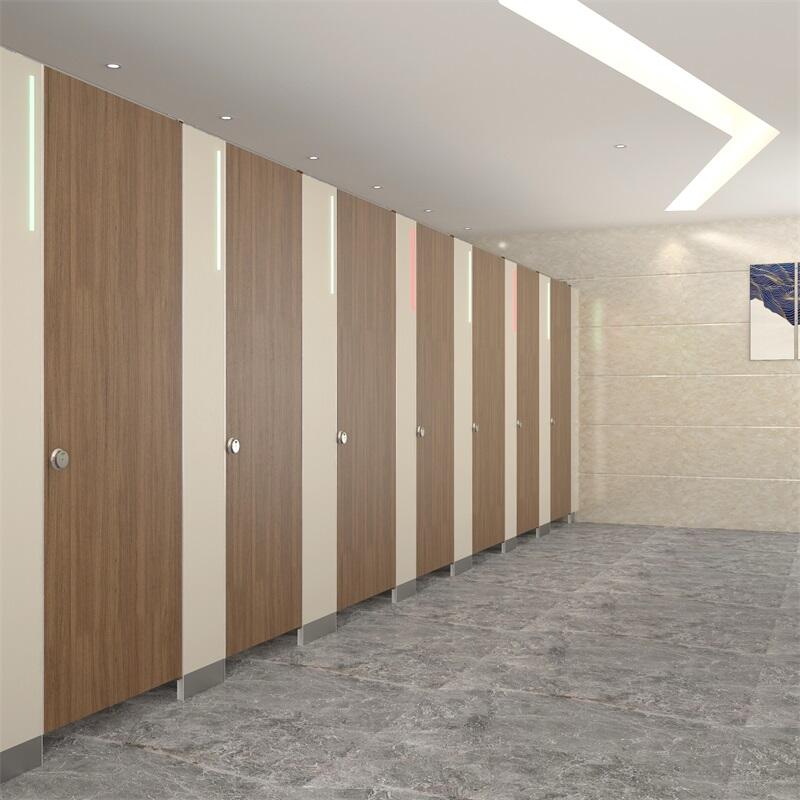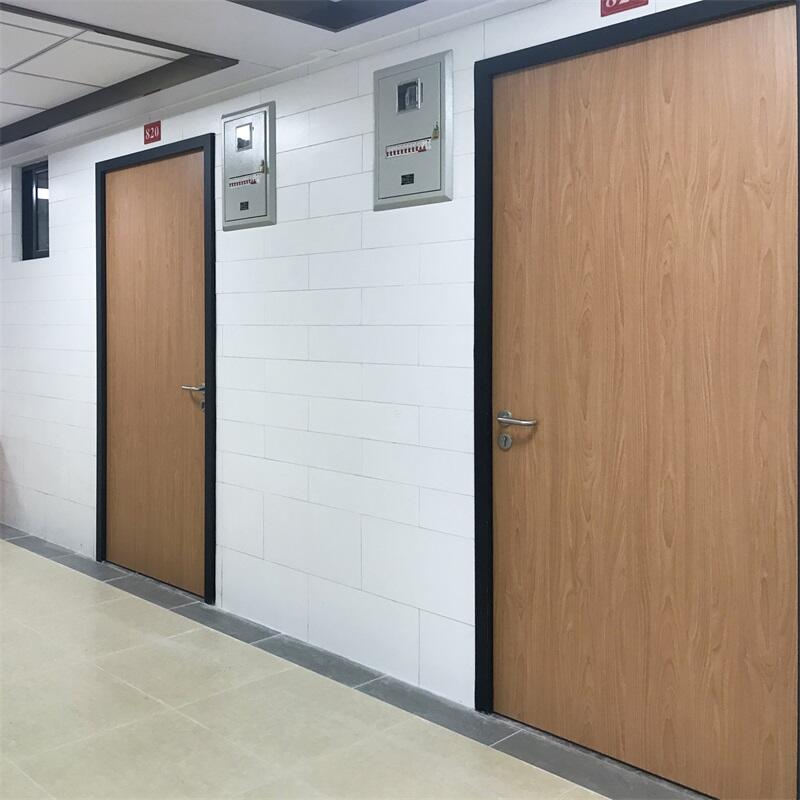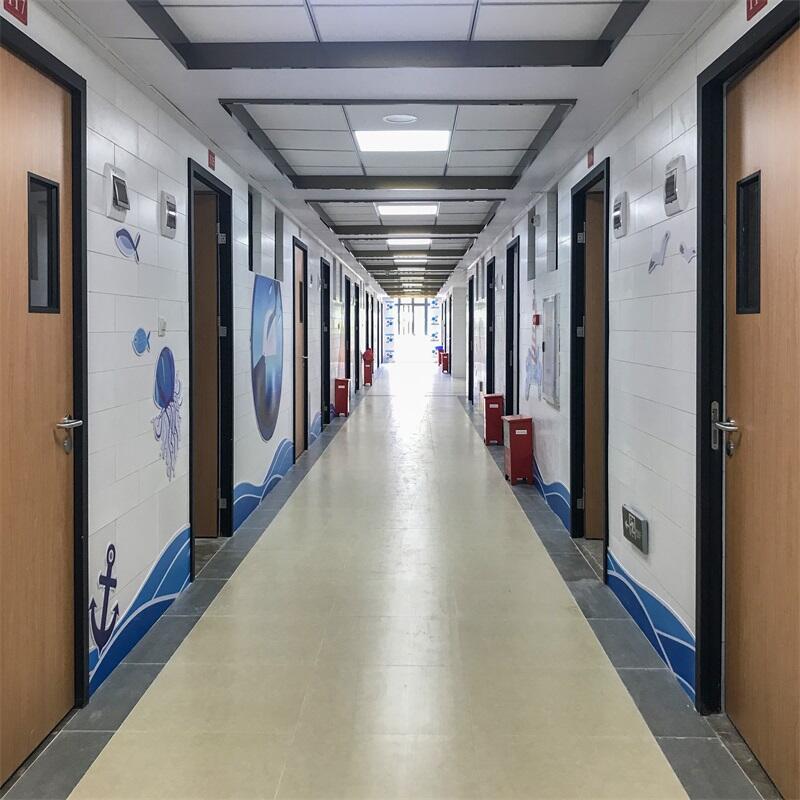วิธีที่แผ่นคลาดผนัง HPL ต้านทานความชื้นได้ดีกว่าวัสดุแบบดั้งเดิม
โครงสร้างแกนรังผึ้งอะลูมิเนียมสำหรับเสถียรภาพที่เหนือกว่า
โครงสร้างรังผึ้งอะลูมิเนียมของแผ่นคลาดผนัง HPL (High-Pressure Laminate) มอบกรอบที่แข็งแรงซึ่งช่วยเพิ่มความสามารถในการต้านทานความชื้น การออกแบบนี้ป้องกันไม่ให้แผ่นคลาดผนังบิดงอหรือขยายตัว ซึ่งเป็นปัญหาทั่วไปของวัสดุแบบดั้งเดิมที่ดูดซับความชื้น การศึกษาแสดงให้เห็นว่าวัสดุที่มีการออกแบบรังผึ้งทนต่อแรงอัดได้ดีกว่า ทำให้เหมาะสำหรับสภาพแวดล้อมที่เปียกชื้น นี่ยืนยันว่า HPL รักษาความสมบูรณ์ของโครงสร้างในสภาพแวดล้อมที่แตกต่างกัน ในขณะที่ตัวเลือกแผ่นคลาดผนังแบบดั้งเดิมอาจเสื่อมลงเมื่อสภาพอากาศเปลี่ยนแปลง โครงสร้างรังผึ้งใน HPL ช่วยให้มันคงที่และน่าเชื่อถือตลอดเวลา
เทคโนโลยีผิวไม่ซึมเพื่อป้องกันการซึมของน้ำ
แผ่นคลาดผนัง HPL มีผิวที่ไม่ซึมซึ่งออกแบบมาโดยเฉพาะเพื่อป้องกันการซึมของน้ำ ทำให้เหมาะสำหรับพื้นที่ที่ต้องการความสะอาดสูง เช่น แผงผนังห้องน้ำและห้องส้วม ไม่เหมือนวัสดุแบบเดิมที่มีรูพรุนซึ่งอาจเกิดเชื้อราและแบคทีเรียได้ ผิวที่ไม่ซึมของ HPL ช่วยให้สภาพแวดล้อมสะอาดขึ้น เทคโนโลยีนี้ไม่เพียงแต่ยืดอายุการใช้งานของแผ่นคลาดโดยการลดความเสียหายจากน้ำ แต่ยังลดต้นทุนการบำรุงรักษาที่เกี่ยวข้อง อีกทั้งยังเพิ่มความเหมาะสมสำหรับพื้นที่ที่เน้นเรื่องสุขอนามัยและความสะอาด
กระบวนการเซ็ตตัวด้วยความร้อนเพื่อความต้านทานต่อความชื้น
กระบวนการผลิตแบบ thermosetting ที่ใช้ในแผ่นคลadding HPL ช่วยเพิ่มความต้านทานต่อความชื้นและความผันผวนของอุณหภูมิอย่างมาก โดยการสร้างโครงข่ายโพลิเมอร์ที่เสถียร วิธีนี้ทำให้แน่ใจว่าแผ่นคลadding จะคงรูปและฟังก์ชั่นไว้ได้แม้ในสภาพแวดล้อมที่มีความชื้นสูง วัสดุแบบดั้งเดิมมักจะเกิดการบิดเบือนภายใต้แรงกดดันเช่นนี้ ซึ่งไม่ใช่ปัญหากับ HPL การวิจัยสนับสนุนว่าผลิตภัณฑ์ที่ทำจากเรซินแบบ thermoset มีประสิทธิภาพเหนือกว่าในสภาพแวดล้อมที่ชื้น การพัฒนาเทคนิคการผลิตนี้ช่วยเสริมชื่อเสียงของ HPL ในด้านความทนทานและความน่าเชื่อถือในสภาพที่ท้าทาย
ข้อดีสำคัญของ HPL เมื่อเปรียบเทียบกับวัสดุแบบดั้งเดิมที่ไวต่อความชื้น
การเปรียบเทียบ: HPL เทียบกับไม้/PVC ในสภาพแวดล้อมที่ชื้น
ในสภาพแวดล้อมที่มีความชื้นสูง HPL ทำงานได้ดีกว่าไม้และ PVC อย่างมาก เนื่องจากไม้และ PVC มีแนวโน้มที่จะบวมและเสียหายเนื่องจากการซึมซับความชื้น คุณลักษณะนี้ทำให้ HPL เป็นตัวเลือกที่น่าเชื่อถือสำหรับพื้นที่ที่มีความชื้นสูง ข้อมูลจากการศึกษาของอุตสาหกรรมแสดงให้เห็นว่าขณะที่ไม้มีแนวโน้มที่จะเสื่อมลงตามเวลา สูญเสียความแข็งแรงทางโครงสร้างและความสวยงาม HPL ยังคงรักษาความแข็งแรงและความสวยงามไว้ได้ ความทนทานนี้ทำให้ HPL เป็นตัวเลือกที่ยอดเยี่ยมสำหรับการใช้งานหลากหลาย เช่น แผงผนังห้องน้ำและแผ่นคลาดผนังภายนอก ซึ่งจำเป็นต้องมีประสิทธิภาพที่คงที่ การที่ HPL สามารถรักษาลักษณะและการทำงานภายใต้สภาพแวดล้อมที่ชื้นได้นั้นยืนยันถึงความเหนือกว่าเมื่อเทียบกับวัสดุแบบดั้งเดิมอย่างไม้และ PVC
คุณสมบัติป้องกันเชื้อราสำหรับพื้นที่ด้านการแพทย์และการบริการโรงแรม
คุณสมบัติป้องกันเชื้อราของ HPL ทำให้มันเหมาะอย่างยิ่งสำหรับสภาพแวดล้อมด้านการดูแลสุขภาพและการบริการ hospitality โดยที่การรักษา มาตรฐานด้านอนามัยเป็นสิ่งสำคัญ เชื้อราและแบคทีเรียอาจยากต่อการจัดการบนพื้นผิวแบบดั้งเดิม แต่ส่วนผสมของ HPL ช่วยยับยั้งการเจริญเติบโตของพวกมันได้อย่างกระตือรือร้น การทดสอบที่สนับสนุนเรื่องนี้แสดงถึงการลดลงอย่างมากในกิจกรรมของจุลินทรีย์เมื่อเทียบกับวัสดุทั่วไป นอกจากนี้ยังไม่เพียงแต่ส่งเสริมสภาพแวดล้อมที่ปลอดภัยและสะอาดมากขึ้น แต่ยังช่วยให้ปฏิบัติตามมาตรฐานสุขภาพที่เข้มงวดในสถานที่ เช่น โรงพยาบาลและโรงแรม อีกด้วย ความสามารถของ HPL ในการรักษาความสะอาดมอบความอุ่นใจที่ล้ำค่าแก่ผู้จัดการสถานที่ที่กังวลเกี่ยวกับความปลอดภัยและความสะอาด
เสถียรภาพทางมิติในภาวะอุณหภูมิเปลี่ยนแปลงอย่างรุนแรง
HPL แสดงความคงตัวทางมิติอย่างน่าทึ่งแม้ในกรณีที่อุณหภูมิเปลี่ยนแปลงอย่างรุนแรง ซึ่งแตกต่างจากไม้และ PVC ที่มักจะบิดหรือแตกร้าวในสภาพดังกล่าว การวิจัยได้แสดงให้เห็นว่า HPL รักษาคุณสมบัติทางกายภาพของมันโดยไม่ถูกกระทบจากความชื้นหรืออุณหภูมิ ทำให้รักษาความสวยงามและความสามารถใช้งานของอาคารได้ นี่ทำให้ HPL เป็นตัวเลือกที่ได้รับความนิยมในพื้นที่ที่มีสภาพอากาศแปรปรวน ซึ่งวัสดุแบบดั้งเดิมมักประสบกับการล้มเหลว โดยการรักษาความสมบูรณ์ผ่านการเปลี่ยนแปลงของอุณหภูมิ HPL จึงเป็นวัสดุที่น่าเชื่อถือสำหรับโครงการสถาปัตยกรรมที่ต้องการประสิทธิภาพและความทนทานในระยะยาว
โซลูชัน HPL ระดับพรีเมียมสำหรับการควบคุมความชื้นที่เหนือกว่า
แผ่นกั้นห้องน้ำ HPL จากพื้นจรดเพดาน (การออกแบบกันน้ำ 100%)
ความสำคัญของการควบคุมความชื้นในสภาพแวดล้อมที่มีความชื้นสูงไม่สามารถเน้นย้ำได้มากเกินไป ซึ่งเป็นเหตุผลว่าทำไมการใช้แผ่นกั้นห้องน้ำ HPL จากพื้นจรดเพดานถึงเป็นตัวเลือกอันดับหนึ่ง การออกแบบที่กันน้ำได้สมบูรณ์ทำให้เหมาะสำหรับห้องน้ำและสระว่ายน้ำ โดยมอบความทนทานและความสามารถในการใช้งานอย่างยาวนาน โครงสร้างที่แข็งแรงและการตกแต่งที่เรียบหรูช่วยเสริมทั้งความสวยงามและความสะอาด ทำให้แผ่นกั้นเหล่านี้เป็นส่วนเสริมที่สมบูรณ์แบบสำหรับพื้นที่สมัยใหม่ บทวิจารณ์ในวงการอุตสาหกรรมเน้นย้ำถึงความทนทานและความมีประสิทธิภาพของแผ่นกั้น HPL ในการรักษาความสะอาดและความพร้อมใช้งานตลอดเวลา
ประตูแผ่น HPL ที่สามารถปรับแต่งได้พร้อมขอบกันความชื้น
ประตูแผ่น HPL ที่สามารถปรับแต่งได้มอบโซลูชันที่ออกแบบมาโดยเฉพาะเพื่อเพิ่มการควบคุมความชื้นและความหลากหลายทางด้านการออกแบบ โดยถูกออกแบบให้เข้ากับพื้นที่ต่าง ๆ ประตูเหล่านี้สร้างเกราะป้องกันที่มีประสิทธิภาพต่อการซึมของน้ำในจุดต่อ เช่นขอบกันความชื้น ซึ่งเป็นจุดที่มักเกิดความเสียหายในแบบแผนเดิม นอกจากนี้ยังมีตัวเลือกในการปรับแต่งเพื่อให้แน่ใจว่าประตูเหล่านี้จะสอดคล้องกับความต้องการด้านสไตล์และฟังก์ชันเฉพาะ ทำให้เป็นตัวเลือกที่หลากหลายสำหรับสภาพแวดล้อมที่แตกต่างกัน
ประตู HPL มาตรฐานโรงพยาบาลพร้อมการปกป้องแบคทีเรีย
ในสภาพแวดล้อมทางการแพทย์ที่สุขอนามัยมีความสำคัญเป็นพิเศษ ประตู HPL ระดับโรงพยาบาลที่มีคุณสมบัติต้านแบคทีเรียขั้นสูงมีบทบาทสำคัญ พวกมันเป็นองค์ประกอบสำคัญของกลยุทธ์ควบคุมการติดเชื้ออย่างครอบคลุมภายในโรงพยาบาล คลินิก และสถานที่ที่คล้ายกัน การทดสอบแสดงให้เห็นว่าประตู HPL ที่ผ่านการรักษาต้านแบคทีเรียสามารถลดจำนวนจุลชีพที่เป็นอันตรายได้อย่างมีประสิทธิภาพเมื่อเทียบกับวัสดุมาตรฐาน ซึ่งช่วยให้มั่นใจได้ว่าจะรักษามาตรฐานการปฏิบัติเกี่ยวกับสุขอนามัยที่เข้มงวดโดยไม่กระทบต่อสไตล์หรือประสิทธิภาพของประตู
ห้องส่วนตัวแบบ HPL ที่บูรณาการ LED สำหรับพื้นที่ที่มีความชื้นสูง
ห้องสุขาแบบ HPL ที่บูรณาการ LED ได้กลายเป็นวิธีแก้ปัญหาใหม่สำหรับพื้นที่ที่มีความชื้นสูง โดยรวมฟังก์ชันการทำงานและความสวยงามไว้อย่างลงตัว การออกแบบนี้ไม่เพียงแต่เพิ่มความน่าสนใจทางสายตาเท่านั้น แต่ยังช่วยจัดการความชื้นอย่างมีประสิทธิภาพ อุปกรณ์ส่องสว่างถูกออกแบบให้เหมาะสมสำหรับใช้งานในพื้นที่ที่มีความชื้นสูง ซึ่งช่วยส่งเสริมความปลอดภัยและลดปัญหาการบำรุงรักษา ผู้ใช้ชื่นชมการออกแบบที่บูรณาการ LED เนื่องจากช่วยเพิ่มทั้งความสามารถในการใช้งานและความสวยงามของห้องน้ำสาธารณะ
การประยุกต์ใช้งานที่เหมาะสมซึ่ง HPL มีประสิทธิภาพในการจัดการความชื้น
สภาพแวดล้อมห้องน้ำและห้องสุขา (แผ่นกั้นห้อง)
ในสภาพแวดล้อมห้องน้ำ HPL ได้พิสูจน์ประสิทธิภาพในการจัดการกับปัญหาที่เกี่ยวข้องกับความชื้นซึ่งมักพบในวัสดุแบบดั้งเดิม พาร์ติชันห้องส้วมที่ทำจาก HPL ถูกออกแบบมาเพื่อทนต่อการใช้งานประจำวันในสภาพอากาศที่ชื้นโดยไม่เสื่อมคุณภาพ ทำให้เหมาะสำหรับสถานที่ที่มีความต้องการสูง การศึกษาแสดงให้เห็นว่าสถานที่ที่ใช้ HPL ในห้องน้ำมีความต้องการการบำรุงรักษาน้อยลงและได้รับประโยชน์จากการมีอายุการใช้งานที่ยาวนานกว่าเมื่อเปรียบเทียบกับการใช้วัสดุพาร์ติชันแบบเดิม ความทนทานนี้ไม่เพียงแต่รักษามาตรฐานทางความงามให้คงที่ แต่ยังประหยัดต้นทุนการบำรุงรักษาในระยะยาว
แผ่นผนังภายนอกสำหรับอาคารในเขตภูมิอากาศชายฝั่ง
การใช้แผ่นเคลือบ HPL เป็นทางออกที่เหมาะสมสำหรับอาคารในภูมิภาคอากาศชายฝั่ง โดยให้ความต้านทานอย่างยอดเยี่ยมต่อน้ำทะเลและความชื้น ซึ่งวัสดุอื่นอาจไม่สามารถทนได้ การศึกษายืนยันถึงความสามารถของ HPL ในการรักษาความสมบูรณ์ของโครงสร้างและความสวยงามแม้อยู่ในสภาพแวดล้อมที่รุนแรงตามพื้นที่ชายฝั่ง นอกจากนี้ HPL ยังเพิ่มประสิทธิภาพพลังงานของอาคารในสภาพแวดล้อมดังกล่าว มอบไม่เพียงแค่ความคงทน แต่ยังสนับสนุนแนวทางการก่อสร้างที่ยั่งยืน
โรงงานแปรรูปอาหารที่ต้องการผิวสัมผัสที่สะอาด
ในวงการโรงงานแปรรูปอาหาร การใช้พื้นผิว HPL มีความสำคัญอย่างยิ่ง สภาพแวดล้อมเหล่านี้ต้องการปฏิบัติตามมาตรฐานสุขอนามัยอย่างเคร่งครัด และ HPL สามารถตอบโจทย์ได้ด้วยคุณสมบัติที่ไม่ซึมและต้านจุลชีพ ซึ่งช่วยป้องกันการปนเปื้อน เพื่อให้สอดคล้องกับข้อกำหนดด้านสุขภาพและการเพิ่มประสิทธิภาพในการปฏิบัติงานด้านความปลอดภัยของอาหาร พื้นผิวที่สะอาดของ HPL ถูกแนะนำโดยผู้เชี่ยวชาญว่าเป็นองค์ประกอบที่จำเป็นในพื้นที่ที่เน้นเรื่องความปลอดภัยของอาหาร
ประโยชน์ของการบำรุงรักษาของระบบ HPL ที่ต้านทานความชื้น
ไม่มีการบิดตัวเมื่อเปรียบเทียบกับแผ่นรองผนังไม้
ข้อได้เปรียบหลักของแผ่นแลมิเนตความดันสูง (HPL) เมื่อเทียบกับวัสดุแบบดั้งเดิม เช่น แผ่นผนังไม้ คือความสามารถในการไม่บิดงอเลย แตกต่างจากไม้ HPL สามารถรักษาทั้งลักษณะและความสามารถในการใช้งานได้แม้อยู่ในสภาพแวดล้อมที่เปียกชื้น รายงานหลายฉบับแนะนำให้ใช้ HPL เป็นทางเลือกที่ดีกว่า โดยเน้นย้ำถึงอายุการใช้งานที่ยาวนานและไม่ต้องบำรุงรักษาซับซ้อน การคงทนนี้ไม่เพียงแต่ลดต้นทุนการเปลี่ยนใหม่ แต่ยังทำให้การดูแลรักษาสะดวกขึ้น ทำให้เหมาะสำหรับพื้นที่ที่มีความชื้นสูง
พื้นผิวที่ต้านทานสารเคมีทำความสะอาดง่าย
HPL มีชื่อเสียงในเรื่องของพื้นผิวที่ต้านทานสารเคมี ซึ่งอนุญาตให้ใช้สารทำความสะอาดมาตรฐานโดยไม่ทำลายวัสดุ ทำให้กระบวนการบำรุงรักษาเป็นไปอย่างง่ายดาย โดยเฉพาะในสภาพแวดล้อมที่มีโอกาสหกเลอะเทอะและเกิดคราบสกปรก ผู้เชี่ยวชาญในอุตสาหกรรมมักสนับสนุน HPL เพราะความสามารถในการทนต่อสารเคมี ซึ่งลดความพยายามและความต้องการใช้เงินในการบำรุงรักษาเมื่อเทียบกับวัสดุแบบดั้งเดิมที่อาจเสื่อมสภาพเมื่อสัมผัสกับสารเคมี
สีที่ทนต่อรังสี UV ป้องกันความเสียหายจากสภาพอากาศ
ความคงทนต่อรังสี UV ของ HPL ช่วยให้สีสันยังคงสดใสตลอดเวลา ป้องกันการซีดจางและการเสื่อมสภาพซึ่งเป็นเรื่องปกติสำหรับวัสดุอื่นๆ คุณสมบัตินี้มีความสำคัญในการรักษาความสวยงาม โดยเฉพาะอย่างยิ่งสำหรับการใช้งานภายนอกที่ถูกแสงแดดส่องถึงเป็นประจำ การวิเคราะห์ตลาดยืนยันว่า HPL สามารถรักษาคุณภาพทางสายตาตลอดอายุการใช้งานได้อย่างมีประสิทธิภาพมากกว่าวัสดุที่ไวต่อความเสียหายจาก UV ทำให้มันเป็นตัวเลือกที่ยอดเยี่ยมสำหรับโครงการที่ต้องการทั้งความทนทานและความคงทนของลักษณะปรากฏ




